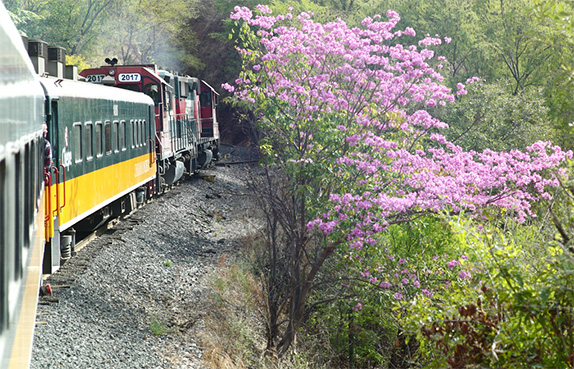
After years of declining customers and service and increasing crime, Mexico finally ended rail passenger service a few years ago—with one exception. The tiny and impossibly scenic Chihuahua al Pacifico line still runs from the prosperous ranching state capital of Chihuahua to the Pacific Ocean, primarily because it is the greatest tourist attraction in the Copper Canyon region of the Sierra Nevada.
A new book, Sierra Challenge: The Construction of the Chihuahua al Pacifico Railroad (Brranca Press, 206 pages), by the late Glenn Burgess and his son Don Burgess, tells the dramatic story of the construction of the railroad in words and photographs.
The Copper Canyon country is one of the wonders of the world, a network of seven canyons, some deeper than the Grand Canyon, with pine and juniper forests on their rims and orchards and tiny farms along perennial streams in the canyon bottoms. The difference in altitude is so great that when the rims are covered with snow, at the bottom fruit trees bloom and kids splash in warm pools. Throughout the canyon country, Tarahumara Indians pursue their isolated lives in small family groups—inexhaustible runners, beautiful craftsmen and impoverished farmers harassed by cartels, woodsmen and soldiers.
I have visited this country twice, once driving to the bottom of Urique, the deepest canyon, and the other time staying in lodges as the guest of the Mexican government and a Mexican airline.
The area is as dramatic and harsh as any on Earth. The railroad is the only practical way of transiting the entire mountain range. Riding it, a passenger can only be awed by the precipitous scenery, with range upon range of mountains receding from the dense forests in the foreground. Canyons dizzyingly deep drop from the forests to streams and waterfalls and miniature villages that are hardly visible.
How in the world could anyone build a railroad through this country? How could anyone even believe such a feat would be possible? Burgess calls it “the impossible dream,” and dedicates the book to the principal dreamer, Mexican engineer Frencisco M. Togno, who died in 1991.
When the railroad was nearing completion in 1955, Glenn Burgess covered the event as a reporter for newspapers in El Paso and Fort Worth. He was also a photographer, a journalism teacher and owner of a camera and curio shop in Alpine, Texas, on the northern edge of the Big Bend country. Four years later, Don Burgess, then a college student in El Paso, worked on the railroad.
Don Burgess wrote the introduction and edited the book, which is based on his father’s articles and photos. It provides an interesting and unusual eyewitness account of one of the world’s most challenging engineering projects.
The Copper Canyon country became a lifetime project for Don Burgess. He studied the two Tarahumara languages, translated books and lived in the Sierra Madre along with his wife, a nurse who helped heal Indians who traveled long distances for her services. They, too, became part of “the impossible dream.”
(Train image via Flickr)

August 23, 2013